When talking about development or redevelopment, it is important to look not only at progress but also at preservation. Taking historical or architectural preservation and conservation of our natural resources into consideration is a much-needed step to create a balance between progress and preservation. The goal of redevelopment is not to wipe out the old to create space for the new but to marry history with modern innovation and the current needs of the community.
When outlining a plan for a redevelopment project, developers carefully consider historical significance, architectural value, and, especially with the advancing promotion of newer green practices, environmental impacts as well as the natural resources and local flora and fauna. They consider ways to utilize existing structures while also maximizing space and efficiency.
The architectural value of a building is often the first item to consider in preservation because it’s easily seen. Era-specific styles, colors, arches, corbels–these things and others prompt developers to find ways to incorporate the architectural heritage of the original building into any new designs. Whenever possible, these elements should be preserved for the future.
Historical preservation looks at historical events and cultural significance. There are many sites around the Oil Region where their historic value has been saved while also allowing the property to be used for exciting new things. Sometimes, this might look like a historic site such as a museum. Other times, like when a building is in such disrepair that it cannot be salvaged, it might simply be a sign or plaque reminder of what had been there.
Conservation in redevelopment covers a vast number of things. Everything from water run-off during construction to potential displacement of migratory birds to replacing invasive plants with natives is considered. Energy efficiency is also carefully thought out. Not only is this important during the construction process, but for the future sustainability of the property. Things like large, energy-efficient windows can lower heating and cooling costs as well as reduce the need for artificial lighting. Planting native plants might attract butterflies and songbirds like the Eastern Bluebird where non-native plants are often invasive and make their way into neighboring spaces by out-competing native species.
Even while taking these three key things into consideration in redevelopment, it is possible for progress to flourish. We can highlight historical and architectural significance, protect our natural resources, and still make steps forward.
If preservation, conservation, or redevelopment interests you, I’d love to hear from you! Stop in to chat on Fridays in Foxburg from 1-3 p.m. at Divani.
Rachel Brosnahan is the Community Engagement Coordinator for River Roots Redevelopment. She can be reached by email at rachel@riverrootsredevelopment.org.









































